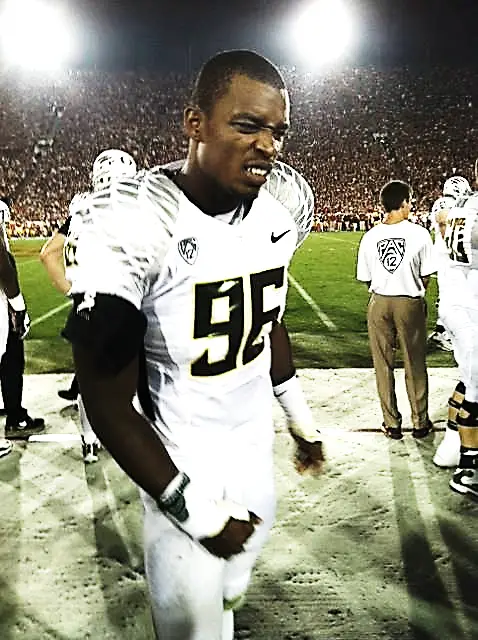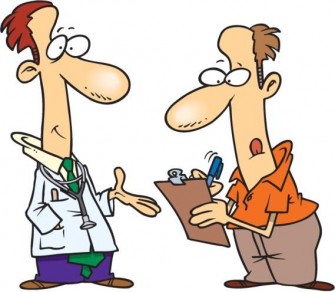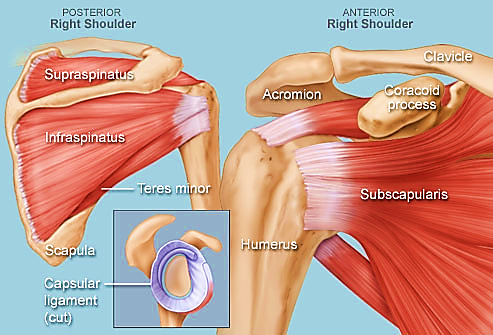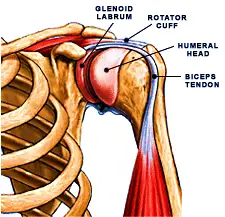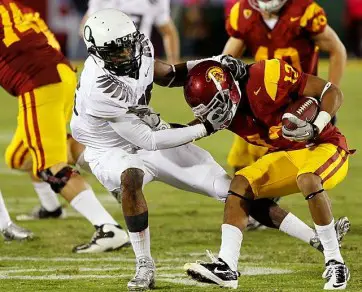Sports Medicine
Shoulder Injuries
By Dr. Jack Dreisen
Figure : Dion Jordan Reinjures Shoulder – We Hope He Recovers Soon!
Figure : “This is what happens with shoulder injuries.”
As I am not privy to the type of injury Oregon players sustain or the severity of it, I can only discuss shoulder injuries in general.
Figure . Shoulder Anatomy
The shoulder is one of the largest and most complex joints in the body. The shoulder joint is formed where the humerus (upper arm bone) fits into the scapula (shoulder blade), like a ball and socket. Other important bones in the shoulder include:
- The acromion is a bony projection off the scapula.
- The clavicle (collarbone) meets the acromion in the acromioclavicular joint.
- The coracoid process is a hook-like bony projection from the scapula.
The shoulder has several other important structures:
The rotator cuff is a collection of muscles and tendons that surround the shoulder, giving it support and allowing a wide range of motion.
The bursa is a small sac of fluid that cushions and protects the tendons of the rotator cuff.
A cuff of cartilage called the labrum forms a cup for the ball-like head of the humerus to fit into.
The humerus fits relatively loosely into the shoulder joint. This gives the shoulder a wide range of motion, but also makes it vulnerable to injury.
Shoulder Conditions
- Frozen shoulder: Inflammation develops in the shoulder that causes pain and stiffness. As a frozen shoulder progresses, movement in the shoulder can be severely limited.
- Osteoarthritis: The common “wear-and-tear” arthritis that occurs with aging. The shoulder is less often affected by osteoarthritis than the knee. However, this is not universal among patients.
- Rheumatoid arthritis: A form of arthritis in which the immune system attacks the joints, causing inflammation and pain. Rheumatoid arthritis can affect any joint, including the shoulder.
- Gout: A form of arthritis in which crystals form in the joints, causing inflammation and pain. The shoulder is an uncommon location for gout.
- Rotator cuff tear: A tear in one of the muscles or tendons surrounding the top of the humerus. A rotator cuff tear may be a sudden injury, or result from steady overuse.
- Shoulder impingement: The acromion (edge of the scapula) presses on the rotator cuff as the arm is lifted. If inflammation or an injury in the rotator cuff is present, this impingement causes pain.
- Shoulder dislocation: The humerus or one of the other bones in the shoulder slips out of position. Raising the arm causes pain and a “popping” sensation if the shoulder is dislocated.
- Shoulder tendonitis: Inflammation of one of the tendons in the shoulder’s rotator cuff.
- Shoulder bursitis: Inflammation of the bursa, the small sac of fluid that rests over the rotator cuff tendons. Pains with overhead activities or pressure on the upper, outer arm are symptoms.
- Labral tear: An accident or overuse can cause a tear in the labrum, the cuff of cartilage that overlies the head of the humerus. Most labral tears heal without requiring surgery.
Acute Shoulder Injuries
- Bicep tendon rupture
- Shoulder contusions
- Shoulder ligament strains or sprains
- Shoulder tendon strains or sprains
- Muscle strains or sprains
- Brachial plexus neuropathy, shoulder injury to the nerve
- Shoulder subluxation or shoulder dislocation
- Rotator cuff tear
- Fracture to the shoulder bones
- Shoulder separation
Sports Shoulder Injuries
- Shoulder dislocations
- ACJ Injuries
- Impingement
- Rotator Cuff Tears
- SLAP Tears
- Biceps Injuries
- Labral tears
- Throwers Shoulder
- Rugby Shoulder
- Swimmers Shoulder
- Fractures
- Frozen Shoulder
- Arthritis
Common sporting injuries of the shoulder include dislocations, Acromioclavicular joint (ACJ) injuries, rotator cuff injuries, Labral tears, thrower’s shoulder, biceps injuries, bursitis and fractures. Dislocations and ACJ injuries are more common in contact sports, such as rugby and wrestling, whilst rotator cuff tears and biceps lesions are common in sports involving explosive heavy weight-lifting. Fractures around the shoulder are seen with sports involving crashes and falls from heights (of which there are many).
It is often quite difficult to adequately assess the severity of a shoulder injury and the structures damaged following sports injuries, as simple muscle strains look very similar to more serious injuries. Thus early assessment from a skilled Shoulder Therapist or Surgeon is essential for early appropriate management. This may involve x-rays, and special scans (e.g., CT Scan, MRI).
Shoulder Dislocations
Because the shoulder joint is the most mobile joint in the body, it is potentially unstable. It is therefore the most common joint to dislocate in the body. In some people only minor trauma can cause the shoulder to ‘pop out’ of joint. If a shoulder does dislocate it needs to be ‘put back’ as soon as possible, and you then require physiotherapy.
Over 50% of dislocations can recur, especially in young sports people. Repeated dislocations lead to more instability and stretching of the shoulder joint, leading to long periods off sports and poor performance. It is therefore recommend to have early surgical fixation. Keyhole repair offers the advantages of less pain, less complications, and an earlier return to sports.
Acromioclavicular Joint Injuries
The hard small lump one feels on the top of the shoulder is the Acromioclavicular Joint (ACJ). This joint is very important for overhead and throwing athletes. It is commonly sprained by repeated falls on the shoulder and tackling. It can also dislocate resulting in a more prominent painful lump on the shoulder.
Sprained joints tend to cause more long-term pain than true dislocated joints. Injections and physiotherapy often improve the pain, but surgical removal of the joint is often required for persisting pain. This operation can be done by keyhole (arthroscopic) surgery, which has the advantages of less post-op pain and an early return to sport. Traditional open surgery can also weaken the shoulder by dividing important ligaments. This is avoided with arthroscopic ACJ excision.
Impingement Syndrome
Subacromial Impingement (also known as Bursitis, Impingement Syndrome, Rotator Cuff Tendinitis, Supraspinatis tendonitis) occurs with repeated use of your arm overhead and in older athletes who develop small bony spurs which trap the rotator cuff tendons above the main shoulder joint. Injections and physiotherapy often improve this condition, but repeated steroid injections should be avoided (especially in athletes).
Surgery involves keyhole ‘spring-cleaning’ of the subacromial bursa with removal of the bony spur. This is called arthroscopic Subacromial Decompression.
Rotator Cuff Tears
The rotator cuff is a very important group of tendons that provide movement and stability for your shoulder; therefore, when it is damaged, pain and weakness can be significant. Tears caused by injury, especially in athletes, benefit from early repair because the tears can get bigger and more difficult to repair later on. Ultrasound scanning in clinic has the advantage of being able to pick up tears early on and treat them appropriately. Rotator cuff repair can be done by keyhole surgery or open surgery. Most tears are repaired by keyhole surgery with the same success rate as for open surgery.
SLAP Lesions
Superior Labral Antero-Posterior (SLAP) tears of the shoulder are more common in overhead throwing, heavy lifting and tackling sports. The biceps anchor in the shoulder is forcibly peeled or pulled off its bone attachment by a large pulling or peeling force. This can occur during a heavy lift, hard throw, tackle or fall. The symptoms are pain deep inside the shoulder with lifting and sports. Some people complain of a clicking sensation and pain extending down the upper arm. It is often difficult to diagnose without actually looking inside the shoulder with an arthroscope (keyhole surgery), which is the recommended treatment for this.
Biceps Injuries
The weak points of the biceps muscle is where the tendon attaches to the bone at the elbow, and the junction between the biceps muscle and its tendon. The biceps usually ruptures at the elbow in athletes. They will commonly feel a pop and notice a lump in the front of their arms. In athletes and manual workers prompt early repair is advisable, as it can be very difficult to repair these later. The biceps may also rupture at the shoulder – this is usually in older people and associate with rotator cuff tears – if surgery is needed the tendon is attached to the humerus (this is called a tenodesis). Biceps Pulley lesions sometimes occur in athletes and should be considered when there is pain on the top and front of the shoulder with normal scans. It is diagnosed by keyhole surgery done by an experienced shoulder surgeon.
Labral Tears
The labrum is a cushion surrounding the socket of the shoulder joint (similar to the meniscus of the knee). Likewise, it can tear like the knee meniscus with injuries of the shoulder. Labral tears usually follow falls or direct blows to the shoulder, but may also occur with throwing or pulling injuries. They can be diagnosed with MR Arthrograms (MR scan with special dye injected into the shoulder joint), and confirmed at keyhole surgery (arthroscopy). Large tears are associated with shoulder dislocations and called Bankart tears.
Thrower’s Shoulder
With repetitive overhead throwing the front of the shoulder can stretch and the back get tighter. This can cause abnormal gliding of the shoulder joint and a ‘catching’ of the labrum and rotator cuff, leading to rotator cuff tears and abnormal wear of the labrum. It requires specific expertise to diagnose and treat this condition.
Rugby Shoulder
We treat a large number of Professional Rugby players and have noticed specific patterns of injury as a result of the intense tackling associated with rugby these days. The injuries are similar to those of the Thrower’s shoulder but not as predictable. Special tests are required to diagnose and treat these specific injuries correctly.
Shoulder fractures
Fractures around the shoulder have always been difficult to treat operatively, thus the results of shoulder fractures have not been as good as other fractures. With new fixation devices and safer surgical techniques we are able to fix difficult fractures early and allow early return to sports better than in the past.
Frozen Shoulder
True frozen shoulder (a very stiff painful shoulder with no obvious cause) is very rare in athletes. However, a stiff painful shoulder following an injury (sometimes, quite minor) is not rare. In these cases it is essential to treat the stiffness early and then also treat the underlying injury that caused the stiffness. The joint teamwork of an experienced physiotherapist and shoulder surgeon is very useful for an early recovery.
Shoulder Arthritis
Arthritis is when a joint wears with age or overuse. The lubricant is reduced and the joint becomes stiff and painful. Keeping the shoulder active and the muscles toned is of benefit, along with painkillers. However, when the pain is severe enough to affect daily life and sleep a joint replacement is of benefit. Resurfacing shoulder replacement has a number of advantages over traditional shoulder replacements with large stems.
The surface replacement for the shoulder with the best published results is the Copeland Surface Replacement Arthroplasty (CSRA). The CSRA also lends itself to insertion by Minimally Invasive Surgical approaches. Hospital stay is reduced (usually 1-2 days) and early return to activities is expected. Patients should be able to move their shoulder the day after surgery.
Sports Shoulder Injuries
Treatment Options
Partial tears to shoulder muscles and ligaments can typically be treated with rehabilitation and bracing. However, specific treatment for a shoulder ligament/tendon injury will be determined by your physician based on age, overall health, medical history, extent of the injury, the patient’s tolerance for specific medications, procedures and therapies. Also, depending on the extent of the injury, treatment may include muscle-strengthening exercises, protective shoulder brace, RICE (rest, ice, compression and elevation), or potentially surgery.
Conservative Treatment Options
This type of recovery may include resting of the muscle and limited activity or rehabilitation therapy, which involves range of motion and strength exercises to help restore the shoulder to full function. These include flexibility and muscle strengthening exercises targeting the muscles around the rotator cuff and scapula. Depending on the injury, physical therapy may last anywhere from a few weeks to a few months. The surgeon may have you perform different exercises in order to help regain strength to the ligament.
Surgical Options
If the ligament is a complete tear or the patient is not healing from rehabilitation therapy, then the surgeon may suggest a complete reconstruction of the ligament in order to prevent further damage and stabilize the shoulder. Arthroscopic surgery may be performed. Surgery may involve the repair, reconstruction or removal of the damaged tissue. Suture anchors may be used to sew the damaged tissue back in place. A physical therapy program will usually follow the surgery in order to strengthen the muscles and restore full joint mobility.
Pain Relief
Effective: Measures that are effective for relieving acute shoulder pain are anti-inflammatory drugs (non-steroidal anti-inflammatory drugs, or ‘NSAIDs’) and corticosteroid injection into the shoulder. Both of these offer short-term pain relief.
In specific conditions that cause shoulder pain (calcific tendonitis and rotator cuff disease, respectively), ultrasound and exercises appear to be effective.
Mixed Results: There are some studies showing that acupuncture relieves acute shoulder pain and some showing it does not work.
Inconclusive: Studies on the use of manual therapy, extracorporeal shock wave treatment (ESWT), oral corticosteroid medication, nerve blocks and TENS for acute shoulder pain have not tested these treatments against placebo.
No Studies Done: There are no studies that have looked at whether pain-relieving medication (analgesics) or surgery are effective for people with acute shoulder pain.
It is important to note that these findings do not mean that these measures will not help; they indicate that more research is needed.
Recovery
Shoulder joint mobilization with combined treatments (hot packs, active exercise, stretching, soft tissue mobilization and education) may improve acute shoulder pain in the short term.
If there is clinical evidence of impingement which has not improved after four weeks of appropriate conservative treatment, then subacromial corticosteroid injection should be considered. This may need to be repeated because the benefit is generally not maintained at 12 weeks.
Therapeutic ultrasound may provide short-term pain relief in calcific tendonitis.
Expected Recovery Timeframes for Shoulder Injuries
Sprain/strain
Expected healing time: 6 weeks
Notes: Most non-specific strain/sprain injuries should heal within 6 weeks.
Rotator cuff tendinopathy
Expected healing time: 2-12 weeks
Notes: Rotator cuff tendinopathy without impingement should resolve with removal of the causative activity and restricting shoulder movement to the pain free range in the acute (first 6 weeks) phase.
Impingement syndrome
Expected healing time: 2-12 weeks<
Notes: Removal of any causative activity will assist healing. Conservative treatment may be unsuccessful.
There will generally be a pain-free range of shoulder movement and the ability to continue activity within that range of movement.
Dislocation
Expected healing time: 3-12 weeks
Notes: Healing depends on whether it is the acromioclavicular or glenohumeral joint which is dislocated, the amount of associated injury and if surgical intervention is required. In most instances healing should occur within 6 weeks.
Bruises/contusions
Expected healing time: 2 weeks
Notes: If there is significant associated tissue injury, particularly with a crush injury, healing may be slower.
Figure : Dion Jordan in Action…hopes that he is feeling better!
Related Articles:
Chip Kelly Update: Everything's Good Again ...
Chip Kelly Update: Wailing and Gnashing of Teeth
Shock and Awe -- The Oregon Ducks' Football Hangover Effect
Despite Lopsided Score, Georgia State "Never Stopped Believing"
Hope Springs Eternal for Ducks
Incompetent Pac-12 Officials: How Do You Miss ALL of THIS?
These are articles where the writer left and for some reason did not want his/her name on it any longer or went sideways of our rules–so we assigned it to “staff.” We are grateful to all the writers who contributed to the site through these articles.

